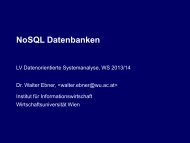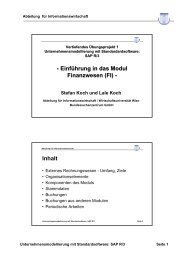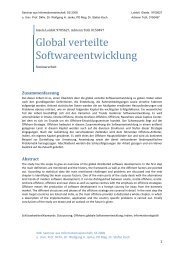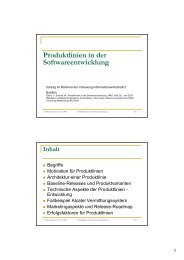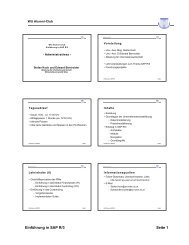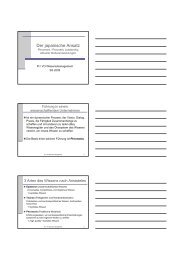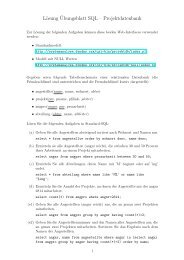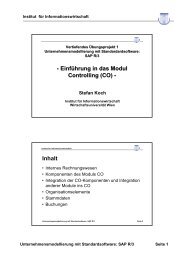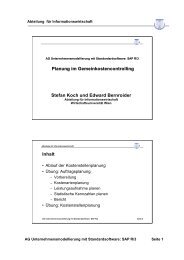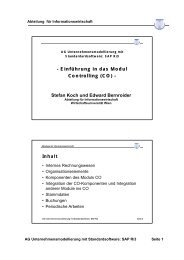A systematic approach to quality function deployment with a full ...
A systematic approach to quality function deployment with a full ...
A systematic approach to quality function deployment with a full ...
You also want an ePaper? Increase the reach of your titles
YUMPU automatically turns print PDFs into web optimized ePapers that Google loves.
138 L.-K. Chan, M.-L. Wu / Omega 33 (2005) 119 – 139<br />
in terms of a cus<strong>to</strong>mer need Wm, then further improvement may not be urgently needed and thus a lower priority could<br />
be assigned <strong>to</strong> Wm. At the other extreme, if C1 performs much worse than many other companies on Wm, then it may<br />
be di cult for C1 <strong>to</strong> build a competitive advantage <strong>with</strong>in a short period of time. In both cases, Wm could be assigned<br />
a lower priority rating. However, if most companies perform quite similarly on Wm, not <strong>to</strong>o much improvement e ort<br />
from C1 may result in a better performance of its product and give C1 a unique competitive advantage. Thus a higher<br />
priority could be assigned <strong>to</strong> Wm. In particular, if all companies’ performances on Wm are the same, it implies a great<br />
market opportunity since any improvement would create a signi cant competitive advantage. So the highest priority could<br />
be assigned <strong>to</strong> Wm. This basis of assigning priorities is interestingly related <strong>to</strong> the entropy concept in information theory.<br />
Entropy is a measure for the amount of information (or uncertainty, variations) represented by a discrete probability<br />
distribution, p1;p2;:::;pL:<br />
L�<br />
pl ln(pl); (A.1)<br />
E(p1;p2;:::;pL)=− L<br />
l=1<br />
where L =1=ln(L) is a normalization constant <strong>to</strong> guarantee 0 6 E(p1;p2;:::;pL) 6 1. Larger entropy or E(p1;p2;:::;pL)<br />
value implies smaller variations among the pl’s and hence less information contained in the distribution. For the mth row<br />
of the cus<strong>to</strong>mer comparison matrix X corresponding <strong>to</strong> the cus<strong>to</strong>mer need Wm;xm1;xm2;:::;xmL, let xm = �L l=1 xml be the<br />
<strong>to</strong>tal score <strong>with</strong> respect <strong>to</strong> Wm. Then according <strong>to</strong> (A.1), the normalized ratings pml = xml=xm for l =1; 2;:::;L can be<br />
viewed as the “probability distribution” of Wm on the L companies <strong>with</strong> entropy as<br />
L�<br />
L�<br />
(xml=xm)ln(xml=xm): (A.2)<br />
E(Wm)=− L<br />
l=1<br />
pml ln(pml)=− L<br />
l=1<br />
It is clear that the larger the E(Wm) value, the less information contained in Wm or smaller variations among the pml’s<br />
(or xml’s). If all companies’ performance ratings on Wm;xm1;xm2;:::;xmL, are the same, Wm has zero variations and E(Wm)<br />
achieves its maximum of 1. So E(Wm) can be used <strong>to</strong> re ect the relative competitive advantage in terms of the cus<strong>to</strong>mer<br />
need Wm. All these E(Wm) values, after normalization:<br />
�<br />
M�<br />
em = E(Wm) E(Wm); m=1; 2;:::;M (A.3)<br />
m=1<br />
can be considered as the cus<strong>to</strong>mer competitive priority ratings for company C1 on the M cus<strong>to</strong>mer needs, <strong>with</strong> a larger<br />
em indicating higher competitive priority for the corresponding Wm.<br />
For more on entropy and its applications, see Refs. [13,22,30–32].<br />
References<br />
[1] Sullivan LP. Quality <strong>function</strong> <strong>deployment</strong>. Quality Progress 1986;19(6):39–50.<br />
[2] American Supplier Institute. Quality <strong>function</strong> <strong>deployment</strong> (service QFD): 3-day workshop. Dearborn, MI: ASI Press; 1994.<br />
[3] Day RG. Quality <strong>function</strong> <strong>deployment</strong>: linking a company <strong>with</strong> its cus<strong>to</strong>mers. Milwaukee, WI: ASQC Quality Press; 1993.<br />
[4] Eureka WE, Nancy ER. The cus<strong>to</strong>mer-driven company: managerial perspective on <strong>quality</strong> <strong>function</strong> <strong>deployment</strong>, 2nd ed. Dearborn,<br />
MI: ASI Press, Burr Ridge, IL: Irwin; 1994.<br />
[5] Hauser JR, Clausing D. The house of <strong>quality</strong>. Harvard Business Review 1988;66(3):63–73.<br />
[6] Bossert JL. Quality <strong>function</strong> <strong>deployment</strong>: a practitioner’s <strong>approach</strong>. Milwaukee, WI: ASQC Quality Press; 1991.<br />
[7] Cohen L. Quality <strong>function</strong> <strong>deployment</strong>: how <strong>to</strong> make QFD work for you. Reading, MA: Addison-Wesley; 1995.<br />
[8] Gri n A, Hauser JR. The voice of the cus<strong>to</strong>mer. Marketing Science 1993;12(1):1–27.<br />
[9] Guinta LR, Praizler NC. The QFD book: the team <strong>approach</strong> <strong>to</strong> solving problems and satisfying cus<strong>to</strong>mers through <strong>quality</strong> <strong>function</strong><br />
<strong>deployment</strong>. New York: Amacom; 1993.<br />
[10] Balthazard PA, Gargeya VB. Reinforcing QFD <strong>with</strong> group support systems: computer supported collaboration for <strong>quality</strong> in design.<br />
International Journal of Quality & Reliability Management 1995;12(6):43–62.<br />
[11] Moskowitz H, Kim KJ. QFD optimizer: a novice friendly <strong>quality</strong> <strong>function</strong> <strong>deployment</strong> decision support system for optimizing product<br />
designs. Computers & Industrial Engineering 1997;32(3):641–55.<br />
[12] Khoo LP, Ho NC. Framework of a fuzzy <strong>quality</strong> <strong>function</strong> <strong>deployment</strong> system. International Journal of Production Research<br />
1996;34(2):299–311.<br />
[13] Chan LK, Kao HP, Ng A, Wu ML. Rating the importance of cus<strong>to</strong>mer needs in <strong>quality</strong> <strong>function</strong> <strong>deployment</strong> by fuzzy and entropy<br />
methods. International Journal of Production Research 1999;37(11):2499–518.<br />
[14] Chan LK, Wu ML. Quality <strong>function</strong> <strong>deployment</strong>: a comprehensive review of its concepts and methods. Quality Engineering<br />
2002;15(1):23–35.<br />
[15] Chan LK, Wu ML. Prioritizing the technical measures in <strong>quality</strong> <strong>function</strong> <strong>deployment</strong>. Quality Engineering 1998;10(3):467–79.<br />
[16] Belhe U, Kusiak A. The house of <strong>quality</strong> in a design process. International Journal of Production Research 1986;34(8):2119–31.




